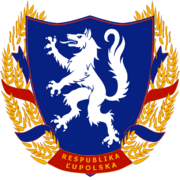Luepolan War: Difference between revisions
No edit summary |
No edit summary |
||
| Line 99: | Line 99: | ||
| units2 = | | units2 = | ||
| strength1 = | | strength1 = | ||
{{flagicon|V_KRV}} '''VKH:'''<br>850,000 men<br>4,500 AFVs<br> | {{flagicon|V_KRV}} '''VKH:'''<br>850,000 men<br>4,500 AFVs<br>4,500 artillery pieces<br>2,700 tanks<br>1,800 aircraft<br>{{flagicon|North Granzery}} '''KFE'''<br>180,000 men<br>1,200 AFVs<br>1,000 artillery pieces<br>400 tanks<br>1,200 aircraft<br>'''Others:'''<br>70,000 men<br>1,400 AFVs<br>900 artillery pieces<br>300 tanks<br>200 aircraft | ||
| strength2 = | | strength2 = | ||
{{flagicon|Luepola}} '''LOV:'''<br>735,000 men<br>3,200 AFVs<br>2,500 artillery pieces<br>1,500 tanks<br>450 aircraft<br>{{flagu|V_SOC|name='''SNVL:'''}}<br>320,000 men<br>1,800 AFVs<br>2,800 artillery pieces<br>1,000 tanks<br>250 aircraft<br>{{flagicon|Vorochia}} '''VSV:'''<br>235,000 men<br>1,500 AFVs<br>2,300 artillery pieces<br>800 tanks<br>530 aircraft | {{flagicon|Luepola}} '''LOV:'''<br>735,000 men<br>3,200 AFVs<br>2,500 artillery pieces<br>1,500 tanks<br>450 aircraft<br>{{flagu|V_SOC|name='''SNVL:'''}}<br>320,000 men<br>1,800 AFVs<br>2,800 artillery pieces<br>1,000 tanks<br>250 aircraft<br>{{flagicon|Vorochia}} '''VSV:'''<br>235,000 men<br>1,500 AFVs<br>2,300 artillery pieces<br>800 tanks<br>530 aircraft | ||
Revision as of 16:06, 6 April 2020
This article is incomplete because it is pending further input from participants, or it is a work-in-progress by one author. Please comment on this article's talk page to share your input, comments and questions. Note: To contribute to this article, you may need to seek help from the author(s) of this page. |
| Luepolan War | |||||||
|---|---|---|---|---|---|---|---|
| Part of the Luepolan Spring and the Silent War | |||||||
| |||||||
| Belligerents | |||||||
|
|
Supported by:
| ||||||
| Commanders and leaders | |||||||
|
|
| ||||||
| Strength | |||||||
|
850,000 men 4,500 AFVs 4,500 artillery pieces 2,700 tanks 1,800 aircraft 180,000 men 1,200 AFVs 1,000 artillery pieces 400 tanks 1,200 aircraft Others: 70,000 men 1,400 AFVs 900 artillery pieces 300 tanks 200 aircraft |
735,000 men 3,200 AFVs 2,500 artillery pieces 1,500 tanks 450 aircraft 320,000 men 1,800 AFVs 2,800 artillery pieces 1,000 tanks 250 aircraft 235,000 men 1,500 AFVs 2,300 artillery pieces 800 tanks 530 aircraft | ||||||
| Casualties and losses | |||||||
|
Total dead: 120,000 Total wounded: 400,000 |
Total dead: 275,000 Total wounded: 620,490 | ||||||
| |||||||
The Luepolan War (Vierz: Lüpolenkrieg), known in Luepola and Vorochia as the Liberation War (Luepolan: Oslobodnočni rát; Vorochian: Визвольна війна), was a war from 1979 to 1985 in Luepola and Vorochia. The conflict was fought between the Central Patyrian Cooperation Association led by the Vierz Empire, and Luepola and Vorochia, who had both unilaterally withdrawn from the CPCA.
The war was preceded by the March Uprising, in which mass protests and riots led to the ousting of the pro-Vierz Luepolan leadership by sympathetic military officers and members of the Sliet. The new Luepolan government's decision to withdraw from the CPCA provoked the Vierz invasion itself, which began in the following August; the invasion was expanded during planning to also target Vorochia after its revolution. The war lasted for six years, ending with the Treaty of Skalla, wherein Vierzland and its allies recognized the new governments of Luepola and Vorochia and agreed to withdraw from the two countries.
The Luepolan War remains the deadliest and most destructive war fought in Patyria since the Great War. The war is also considered the climax of the Silent War, as the weakening of Vierzland's economy and military over the course of the war hastened the breakdown of the CPCA and the start of the Vierz Revolution. The war is also considered to comprise the second phase of the Luepolan Spring.
Background
Course of the war
1979: Vierz Invasion
1980: Halting of the Vierz offensive
1981-82: Stalemate and increased foreign involvement
1982-83: Luepolan Insurgency intesifies
1984: Luepolan Counteroffensive
1985: Second Stalemate and Peace Negotiations
Aftermath
Foreign Involvement
Supporting Vierzland
While Operation Modi was undertaken primarily by Vierzland, most of the CPCA's key members also participated in various capacities. North Granzery was the largest contributor to the war effort apart from Vierzland itself, however heavy casualties and the unpopularity of the war in North Granzery was one of the greatest contributing factors in the abdication of King István Viktor and the ensuing reunification of Granzery. Additionally, Vyzinia, Zacotia, Plosenia, and Tanavia each contributed military contingents, while Borland and Lairea supported the war diplomatically. Vierzland's key non-CPCA ally Savland did not contribute to the Vierz effort.
Supporting Luepola and Vorochia
The Aitic Union, despite facing social unrest of its own against the communist government, became the primary foreign military supplier of Luepola and Vorochia during the war until its dissolution in 1984. The Aitic Union's aid consisted firstly of small arms smuggled across the Vorochian border and with humanitarian shipments to Bosunija, but later grew to include tanks and aircraft, broken down and shipped to Luepola and Vorochia, along with military advisors. In 2006, it was revealed in a series of interviews with former partisan and other insurgent commanders that they were supplied with weapons and training from Aitic military personnel operating in Vierz-controlled territory.
The Continental Security Organization, with the exception of South Granzery, also supplied Luepolan and Vorochian forces with weapons, ammunition, and advisors deployed to Bosunija. In addition, the TBN Military Exercise hosted in Apelia in 1983, which brought the CSO and CPCA to the brink of war, forced Vierzland to withdraw units from Luepola to deploy to the Apelian border in anticipation of a possible war, relieving pressure on Luepolan and Vorochian forces and enabling them to mount a sweeping counteroffensive. Though never officially acknowledged as such, the timing of the exercise is widely recognized to have been a deliberately calculated geopolitical maneuver by the CSO.





